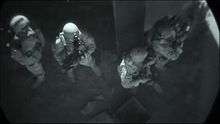Special Forces Tab
| Special Forces Tab | |
|---|---|
 | |
| Awarded by United States Army | |
| Type | Tab |
| Status | Currently awarded |
| Statistics | |
| Established | 1983 |
| Last awarded | Current |
| Precedence | |
| Next (lower) | Ranger Tab[1] |
Earning the Special Forces Tab
 Official U.S. Army video about the Special Forces Tab |
The Special Forces Tab is a service school qualification tab of the United States Army, awarded to any soldier completing either the Special Forces Qualification Course, or the Special Forces Detachment Officer Qualification Course (formerly known as the Special Forces Officer Course), at the U.S. Army John F. Kennedy Special Warfare Center and School, Fort Bragg, North Carolina (previously known as the U.S. Army Institute for Military Assistance). Soldiers who are awarded the Special Forces Tab are authorized to wear it for the remainder of their military careers, even when not serving in a Special Forces command.
Because it is longer than the other qualification tabs, it is called the "Long Tab". Personnel who have earned it are nicknamed "Long Tabbers".
Description and history
The Special Forces Tab was created in 1983 and is an embroidered quadrant patch worn on the upper left sleeve of a military uniform. The cloth tab is 3 1⁄4 inches wide and is teal blue with yellow embroidered letters. A metal Special Forces Badge is authorized for wear on the mess/dress uniforms and green shirt. The metal badge is teal blue with a gold edge and gold letters.[2]
At the time of its creation, the Special Forces Tab was retroactively awarded to any Army soldiers previously Special Forces-qualified. In addition, as set forth in Army regulations, veterans of certain categories of former wartime service are also eligible for retroactive awards of the tab. Among these are:[3]
- personnel who served with a Special Forces unit during wartime between 1942 and 1973 and were either unable to or not required to attend a formal program of instruction but were awarded the proper Special Qualification Identifier by a competent authority. U.S. Army Warrant Officers are excluded.
- personnel with at least 120 days' wartime service prior to 1955 in certain units, including the 1st Special Service Force, OSS Detachment 101, OSS Jedburgh teams, OSS Operational Groups, and the Sixth Army Special Reconnaissance Unit ("Alamo Scouts"), and
- personnel captain and below awarded the Combat Infantryman Badge or Combat Medical Badge while serving at least 120 days wartime service between 1955 and 1975 in a Special Forces Operational Detachment-Alpha or certain other units. Does not apply to U.S. Army Warrant Officers.
Before creation of the Special Forces Tab, Special Forces status was indicated by wearing a full-size unit flash on the green beret. A support soldier (military intelligence soldiers, signal personnel, parachute riggers, clerical and administrative personnel, etc.) assigned to a Special Forces unit wore a 1/4" high bar (nicknamed a "Candy Stripe") below the Special Forces Crest on their green beret. The bar matched the colors of the unit's flash. This was not, however, the norm during the Vietnam war, when all soldiers assigned to 5th Special Forces wore identical unit flashes. After the creation of the tab in 1983 and until January 1993, all personnel in a Special Forces unit wore the same beret and flash. Today, only Special Forces-qualified soldiers may wear the green beret, making obsolete the unit bar under the flash. Each Special Forces Group has its own unique beret flash, which is worn by all members assigned to the unit; Special Forces-qualified soldiers wear it on the green beret while support personnel wear it on the maroon beret.
Other tabs
It is currently one of four permanent individual skill/marksmanship tabs (as compared to a badge) authorized for wear by the U.S. Army. In order of precedence, they are the Special Forces Tab, the Ranger Tab, and the Sapper Tab. Only three may be worn at one time. The President's Hundred Tab is a similar qualification tab which is authorized for soldiers who qualify among the top 100 scoring competitors in the President’s Match held annually at the National Rifle Matches at Camp Perry, Ohio.